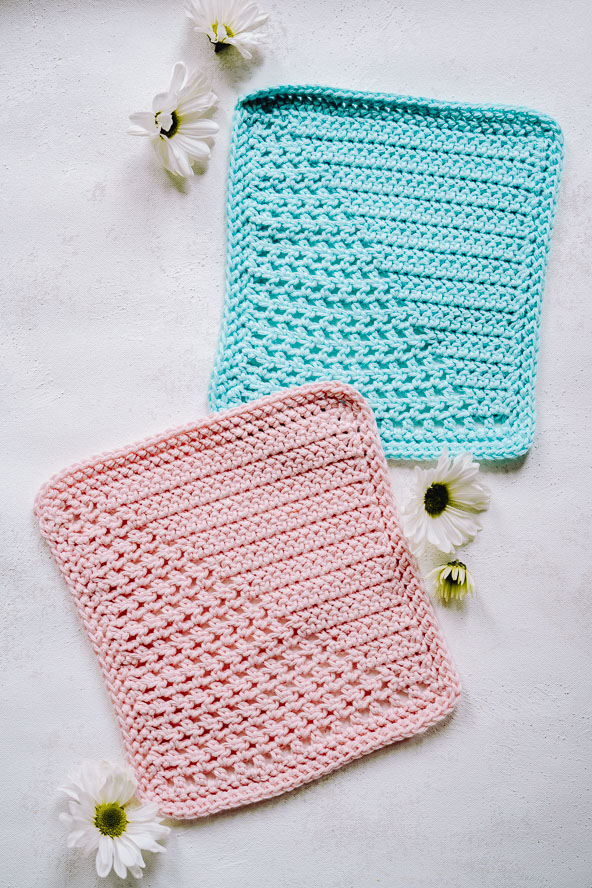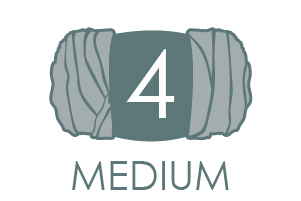
The Dual Texture Dishie is a perfect fusion of practicality and elegance. This dishcloth boasts a clever design featuring a lacy half for navigating into intricate spaces and a sturdy, solid side for effective scrubbing. Designed as an enjoyable introduction to filet crochet and the herringbone stitch, this pattern offers both functionality and a learning experience. The duality of textures in this dishcloth makes it a versatile tool for kitchen chores, seamlessly marrying form and function. Crocheting this delightful dishcloth takes just a day, making it an easy and swift project suitable for crafters at an easy skill level.
Time: 1 Day
Skill Level: Easy
Size: 8.25” wide x 9” tall
Gauge: 15 sts = 4” [10 cm) and 9 rows = 3” [7.6 cm] in hbhdc st after wet blocking
Materials
 Yarn: Universal Yarn Cotton Supreme (100% Cotton; 180 yards [165 meters] / 3.5 ounces [100 grams]): 607 Blush (1 ball) or 516 Aqua (1 ball)
Yarn: Universal Yarn Cotton Supreme (100% Cotton; 180 yards [165 meters] / 3.5 ounces [100 grams]): 607 Blush (1 ball) or 516 Aqua (1 ball)
Hook: US size H/8/5.0 mm
Notions: tapestry needle
Abbreviations
Hbhdc = herringbone half double crochet
Special Stitches
Herringbone half double crochet (hbhdc): Yarn over, insert hook in stitch, yarn over, pull through stitch and first loop on hook, yarn over, draw through remaining two loops on hook.
Pattern Notes
This pattern is worked in rows, then 2 rounds of edging are worked in the round.
Ch-3 at beginning of row counts as hdc and ch-1.
Ch-1 at beginning of row does not count as a stitch.
Pattern
Ch 30.
Row 1: Hdc in 4th ch from hook (counts as hdc and ch-1), *sk 1 ch, ch 1, hdc in next ch, rep from * across, turn. (15 hdc, 14 ch-1)
Row 2: Ch 3 (counts as hdc and ch-1), sk first ch-1 sp, hdc in next st, *sk ch-1 sp, ch 1, hdc in next st, rep from * across to second to last ch-1 sp, hbhdc in each of next (ch-1 sp, hdc, ch-1 sp), sk last hdc, turn. (13 hdc, 12 ch-1, 3 hbhdc)
Row 3: Ch 1 (does not count as a st), hbhdc in each st to ch-1, *sk ch-1, ch 1, hdc in next st, rep from * across, turn. (4 hbhdc, 12 hdc, 12 ch-1)
Row 4: Ch 3, sk first ch-1 sp, hdc in next st, *sk ch-1 sp, ch 1, hdc in next st, rep from * across to last ch-1 sp, hbhdc in ch-1 sp and each st across, turn. (12 hdc, 11 ch-1, 5 hbhdc)
Rows 5-22: Rep rows 3 & 4 alternately. (23 hbhdc, 3 hdc, 2 ch-1)
Row 23: Ch 1, hbhdc in each st to ch-1, hbhdc in ch-1, hbhdc in next st, sk last ch-1, ch 1, hdc in last st, do not turn. (25 hbhdc, 1 hdc, 1 ch-1)
Border
Work the next 2 rounds around all four edges of dishcloth.
Rnd 1: Ch 1, turn, work 1 hbhdc at the end of each row or stitch around dishcloth and ch 1 in each corner, join with sl st. (103 hbhdc, 4 ch-1)
Rnd 2: Ch 1, work (hbhdc, ch 1, hbhdc) in each corner ch-1 and 1 hbhdc in each st around. (111 hbhdc)
Fasten off.



I like videos, do you have any videos to watch instead of reading??
You can browse our videos here: https://www.ilikecrochet.com/tag/video/
Is this picture correct? How do you get the dual pattern when all you’re doing repeating rows 3 and 4?
From the designer: Rows 3 and 4 do not have a specific stitch count. Instead, they have you making certain stitches until you reach a specific type of stitch, namely the ch-1. At that point, you’ll change what you do. The ch-1 moves each row which gives you the diagonal effect. It’s kind of like magic! Hope this helps! – Nicola, Editor
Is there a video on this pattern? I am confused as to where to place the ch 1.
Hi Joan, not quite sure we understand the question, I don’t understand the question. “where to place the ch 1”. Is the question for the beginning of Row 2?
A ch 1 is not worked into a stitch, so you just need to ch 1 after making a hdc. Then on the row below, skip the ch-1 sp and work a hdc in the next st.
Hope this helps. – Nicola, Editor